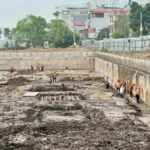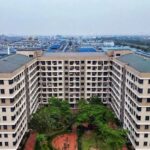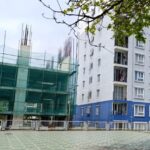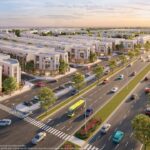Low-income earners struggle as social housing prices surge
A decade ago, social housing in Hanoi was priced at under VND 15 million per square meter. However, since 2023, prices for low-income housing have been on the rise.
For instance, in 2023, the NHS Trung Van social housing project in Trung Van ward, Nam Tu Liem district, was priced at over VND 19.5 million per square meter (including value-added tax).
Another social housing project in Ha Dinh, Tan Trieu, Thanh Tri district, which is still under construction and not yet accepting purchase applications, has a tentative price of VND 25 million per square meter.
The market was taken by surprise when the Rice City Long Chau social housing project in Long Bien district announced a tentative price of VND 26-27 million per square meter.
 The NHS Trung Van social housing project in Trung Van ward is priced at over VND 19.5 million per square meter. Photo: Nguyen Le |
At these prices, the smallest unit of 32 square meters in the project would cost approximately VND 864 million, while the largest unit of 77 square meters would cost about VND 2.08 billion.
After saving for several years working in Hanoi, Mr. and Mrs. Thu Trang are worried about the limited number of social housing projects and the ever-increasing prices.
“My husband and I earn about VND 25 million per month. After deducting rent, our child’s education fees, and living expenses, we’re not sure if we can afford to repay both the principal and interest on a VND 1 billion loan to buy social housing,” shared Mrs. Trang.
Reasons behind the soaring cost of social housing
Mr. Nguyen Anh Que, Chairman of G6 Group, attributed the rising prices of social housing to increased construction costs, including building materials and labor, over the past few years.
Additionally, he pointed out changes in regulations between Decree 100/2024 and Decree 100/2015 regarding profit calculation for social housing and land tax for the 20% commercial area within social housing projects.
“Under Decree 100/2015, the profit for the 20% commercial area was included in the total profit cap of 10% for social housing projects. This meant that the 20% commercial area was exempt from land tax.
For example, the NHS Trung Van project’s approved price of VND 19.5 million per square meter was based on Decree 100/2015. If Decree 100/2024 were applied, the price would be around VND 27 million per square meter.
Currently, under Decree 100/2024, the profit for the social housing portion is still capped at 10%, but the profit for the 20% commercial area is calculated separately and subject to land use tax.
For instance, at the social housing project in Ngo 214 Ha Dinh, the selling price for social housing is expected to be VND 25 million per square meter, while the commercial area can be sold at market price, potentially reaching VND 70 million per square meter,” explained Mr. Que.
According to the leader of G6 Group, for developers constructing social housing for workers or in districts and provinces, where the selling price for social housing is below VND 15 million per square meter and the selling price for commercial units is below VND 20 million, the profit margin is not significant.
However, in large cities like Hanoi, Ho Chi Minh City, Haiphong, and Danang, the approved price for social housing can reach VND 27 million per square meter, and the 20% commercial area can be sold at nearly VND 100 million per square meter, resulting in considerable profits for developers.
Therefore, Mr. Que proposed combining the profits from the social housing and commercial areas, as was previously done, and increasing the profit margin for social housing developers to 13%. Additionally, he suggested exempting the 20% commercial area from land use tax and waiving the 5% value-added tax on social housing.
“If these proposals are accepted and implemented, the social housing project at Nguyen Xien would be priced below VND 20 million per square meter, and the Rice City Long Chau project would be below VND 21 million per square meter,” affirmed Mr. Que.
Nguyen Le
– 09:49 20/06/2025
The Rising Cost of Social Housing
Social housing in Hanoi is becoming increasingly expensive, with some projects priced at up to 27 million VND per square meter. This price exceeds the affordability of many low-income earners, and with the current requirement that an individual must earn less than 15 million VND per month to qualify for social housing, many are now being priced out of the market.
The Rising Cost of Social Housing
Social housing in Hanoi is becoming increasingly expensive, with some projects reaching up to 27 million VND per square meter. This price surge has sparked concerns among experts, who believe that such high prices exclude a significant portion of low-income earners. With the current regulations in place, individuals earning less than 15 million VND per month would find it challenging to purchase social housing at these elevated rates.
Affordable Housing: Making Homes Accessible to Low-Income Earners
“To catalyze the development of social housing, experts emphasize the need to focus on core elements such as land allocation, credit support, and streamlined investment procedures. Accurate and comprehensive consideration of land acquisition costs is also vital.”
Da Nang Launches Affordable Housing Project with Apartments Starting from VND 800 Million
“The latest news from the Danang Construction Department reveals an exciting opportunity for prospective homeowners. On May 27th, the department announced the release of affordable housing units in the An Trung 2 Apartment Complex, located in the vibrant neighborhood of An Hai Nam, Son Tra district. These homes are specifically designed for individuals and families with low to moderate incomes, offering a chance to own a quality home in a desirable location.”














































